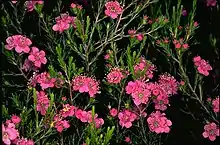Kunzea pauciflora
Kunzea pauciflora, the Mount Melville kunzea,[2] is a species of flowering plant in the myrtle family Myrtaceae, and is endemic to a small area on the south coast of Western Australia. It is a shrub with the stems densely branched near their ends, linear leaves and one, two or three pink flowers near the ends of the branches but usually only at the top of the shrub.
| Mount Melville kunzea | |
|---|---|
 | |
| Kunzea pauciflora in the ANBG | |
| Scientific classification | |
| Kingdom: | Plantae |
| Clade: | Tracheophytes |
| Clade: | Angiosperms |
| Clade: | Eudicots |
| Clade: | Rosids |
| Order: | Myrtales |
| Family: | Myrtaceae |
| Genus: | Kunzea |
| Species: | K. pauciflora |
| Binomial name | |
| Kunzea pauciflora | |
Description
Kunzea pauciflora is a shrub that typically grows to a height of 0.35–1.5 m (1 ft 2 in–4 ft 11 in) with stems that are densely branched near their ends. The leaves are linear, 3.5–6.5 mm (0.14–0.26 in) long and 0.4–1.0 mm (0.016–0.039 in) wide on a petiole 0.4–1.0 mm (0.016–0.039 in) long. The flowers appear singly, in pairs or groups of three to five on the ends of long shoots or branches. There are egg-shaped bracts 2.5–3.5 mm (0.098–0.138 in) long and about 1.5 mm (0.059 in) wide and pairs of lance-shaped bracteoles at the base of the flowers. The sepals are triangular, 2–2.6 mm (0.079–0.102 in) long and glabrous and the petals are pink, egg-shaped to more or less round and 3.5–4 mm (0.14–0.16 in) long. There are between 39 and 46 stamens 3.3–4.1 mm (0.13–0.16 in) long arranged in several whorls. Flowering occurs between August and November and the fruit is an urn-shaped capsule with the erect sepals attached.[3][4]
Taxonomy and naming
Kunzea pauciflora was first formally described in 1844 by Johannes Conrad Schauer and published in Johann Georg Christian Lehmann's book Plantae Preissianae from a specimen collected near Cape Riche.[5][6] The specific epithet (pauciflora) is derived from the Latin words paucus meaning "few" or "little"[7]:489 and flos meaning "flower" or "blossom".[7]:338[8][9]
Distribution and habitat
Mount Melville kunzea is found on hillside and slopes near the coast around Cape Riche in the Fitzgerald River National Park, where it grows in gravelly sandy or loamy soils over limestone or sandstone.[3][4]
Conservation status
Kunzea pauciflora is classified as "Priority Four" by the Government of Western Australia Department of Parks and Wildlife,[4] meaning that it is rare or near threatened.[10]
References
- "Kunzea pauciflora". Australian Plant Census. Retrieved 16 April 2019.
- "Advice to the Minister for the Environment and Heritage" (PDF). Australian Government Department of the Environment. Retrieved 16 April 2019.
- Toelken, Hellmut R. (1996). "A revision of the genus Kunzea (Myrtaceae) I. The Western Australian section Zeanuk". Journal of the Adelaide Botanic Gardens. 17: 90–92.
- "Kunzea pauciflora". FloraBase. Western Australian Government Department of Parks and Wildlife.
- "Kunzea pauciflora". APNI. Retrieved 16 April 2019.
- Schauer, Johnaaes Conrad (1844). Plantae Preissianae (Volume 1). Hamburg. p. 124. Retrieved 16 April 2019.
- Brown, Roland Wilbur (1956). The Composition of Scientific Words. Washington, D.C.: Smithsonian Institution Press.
- Allen J. Coombes The A to Z of Plant Names: A Quick Reference Guide to 4000 Garden Plants, p. 106, at Google Books
- D. Gledhill The Names of Plants, p. 220, at Google Books
- "Conservation codes for Western Australian Flora and Fauna" (PDF). Government of Western Australia Department of Parks and Wildlife. Retrieved 16 April 2019.
